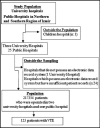Prevalence and risk factors of venous thromboembolism in postoperative patients: A retrospective study
- PMID: 30559819
- PMCID: PMC6290213
- DOI: 10.12669/pjms.346.16021
Prevalence and risk factors of venous thromboembolism in postoperative patients: A retrospective study
Abstract
Objective: To investigate the prevalence of and risk factors for Venous Thromboembolism (VTE) in postoperative patients.
Methods: This descriptive, cross-sectional, retrospective study was conducted from August 2016 to October 2016 at two university hospitals and one public hospital. Total 217,354 patients records who underwent surgery in between 2010 and 2015 were examined. The study sample consisted of 123 patients who had postoperative venous thrombosis and pulmonary embolism, and whose discharge details, consultation data, diagnostic reports, and tests were examined in detail.
Results: The prevalence of VTE in postoperative patients was 5.6/10,000. The mean age of the patients was 60.22±18.56 years. Of 123 patients, 51.20% were male, 30.90% were smokers, 46.30% had a comorbid disease, and 27.60% were diagnosed with cancer. Of the patients who had postoperative VTE, 65.0% had major surgery. Pharmacologic thromboprophylaxis was used in only 24.4% of patients (n=30).
Conclusion: The prevalence of VTE in the present study is lower than that in other studies. Because surgery is a risk factor for VTE, patients who will be operated should be assessed. Considering the present results, we can assume that patients' conditions are not being assessed appropriately. In addition, findings indicate that a standard for preventing VTE has not yet been established.
Keywords: Patients; Postoperative; Prevalence; Venous Thromboembolism.
Similar articles
-
Prevalence of venous thromboembolism after lung surgery in China: a single-centre, prospective cohort study involving patients undergoing lung resections without perioperative venous thromboembolism prophylaxis†.Eur J Cardiothorac Surg. 2019 Mar 1;55(3):455-460. doi: 10.1093/ejcts/ezy323. Eur J Cardiothorac Surg. 2019. PMID: 30289479
-
Clinical analysis of postoperative venous thromboembolism in Japanese patients after colorectal cancer surgery.Surg Today. 2021 Jun;51(6):1022-1027. doi: 10.1007/s00595-020-02201-5. Epub 2021 Jan 2. Surg Today. 2021. PMID: 33387025
-
Risk of Venous Thromboembolism After Laparoscopic Surgery for Gynecologic Malignancy.J Minim Invasive Gynecol. 2016 Nov-Dec;23(7):1057-1062. doi: 10.1016/j.jmig.2016.06.011. Epub 2016 Jun 21. J Minim Invasive Gynecol. 2016. PMID: 27353413
-
Extended thromboprophylaxis with low-molecular-weight heparins after hospital discharge in high-risk surgical and medical patients: a review.Clin Ther. 2009 Jun;31(6):1129-41. doi: 10.1016/j.clinthera.2009.06.002. Clin Ther. 2009. PMID: 19695383 Review.
-
Epidemiology of venous thromboembolism in Africa: a systematic review.J Thromb Haemost. 2017 Sep;15(9):1770-1781. doi: 10.1111/jth.13769. Epub 2017 Aug 10. J Thromb Haemost. 2017. PMID: 28796427
Cited by
-
Association between obesity and venous thromboembolism.Med Pharm Rep. 2020 Apr;93(2):162-168. doi: 10.15386/mpr-1372. Epub 2020 Apr 22. Med Pharm Rep. 2020. PMID: 32478322 Free PMC article.
-
Improving Venous Thromboembolism Prophylaxis Through Service Integration, Policy Enhancement, and Health Informatics.Glob J Qual Saf Healthc. 2024 Feb 12;7(1):22-27. doi: 10.36401/JQSH-23-16. eCollection 2024 Feb. Glob J Qual Saf Healthc. 2024. PMID: 38406656 Free PMC article.
-
Venous thromboembolism prophylaxis usage among surgical patients in both private and public hospitals in Ethiopia.Heliyon. 2024 Jun 26;10(13):e33450. doi: 10.1016/j.heliyon.2024.e33450. eCollection 2024 Jul 15. Heliyon. 2024. PMID: 39040325 Free PMC article.
-
A predictive model of preoperative risk factors for venous thromboembolism after fusion for degenerative conditions of the thoracolumbar spine.J Orthop. 2020 Nov 19;22:598-601. doi: 10.1016/j.jor.2020.11.015. eCollection 2020 Nov-Dec. J Orthop. 2020. PMID: 33299272 Free PMC article.
-
Impact of obesity on clinical outcomes in patients with high-risk pulmonary embolism: A comparative analysis.Int J Cardiol Heart Vasc. 2025 Apr 18;58:101682. doi: 10.1016/j.ijcha.2025.101682. eCollection 2025 Jun. Int J Cardiol Heart Vasc. 2025. PMID: 40297384 Free PMC article.
References
-
- Goldhaber SZ. Venous thromboembolism:Epidemiology and magnitude of the problem. Best Pract Res Clin Haematol. 2012;25(3):235–242. doi:10.1016/j.beha.2012.06.007. - PubMed
-
- Mazzolai L, Aboyans V, Ageno W, Agnelli G, Alatri A, Bauersachs R, et al. Diagnosis and management of acute deep vein thrombosis:a joint consensus document from the European society of cardiology working groups of aorta and peripheral vascular diseases and pulmonary circulation and right ventricular function. Euro Heart J. 2017;39(15):1316–1329. doi:10.1093/eurheartj/ehx003. - PubMed
-
- Agnelli G. Prevention of Venous Thromboembolism in Surgical Patients. Circulation. 2004;110(24):4–12. - PubMed
LinkOut - more resources
Full Text Sources

